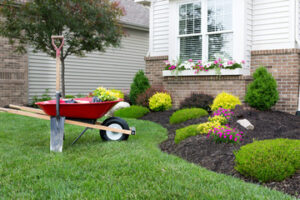Landscaping brings nature and all of its benefits into residential areas. These benefits include air quality improvement, lowered stress levels, reduced soil erosion and more.

Color plays an important role in landscape design. Flowers, trees and shrubs in varying colors add depth to your landscape. Try using a color wheel for a more cohesive look. Visit https://www.primecutlawnky.com/ to learn more.
There are many benefits to landscaping, including the ability to boost property value, beautify an outdoor area, and provide health benefits. Landscaping can also help to increase the lifespan of outdoor structures, such as patios and walkways. It can also save homeowners money on energy costs by shading homes in the summer and insulating them from cold winter winds. Additionally, well-maintained landscaping can attract more wildlife to a home or business.
The most obvious benefit of landscaping is its aesthetic appeal. However, it can also improve the functionality of a space by providing a place to relax or entertain guests. It can also add privacy by planting trees or fences. Landscaping can also reduce noise pollution by blocking out unwanted noises. Finally, it can help with erosion and drainage problems by preventing stormwater runoff.
Landscaping can also promote a business or institution by demonstrating its commitment to environmental protection and sustainability. This is especially important for new or prospective customers, as people are increasingly concerned about the damage that humans are doing to the environment.
Moreover, landscapes can make people feel happy and relaxed, which can improve their mood. This is because landscapes can reduce the production of cortisol, a stress hormone. In addition, they can lower blood pressure and improve overall heart health. Finally, landscapes can provide a place for physical activity, such as gardening and walking.
Moreover, landscapes can help to improve the quality of the air by absorbing carbon dioxide and producing oxygen. In addition, they can cool the air by shading things that usually absorb heat, such as buildings and concrete. They can also help to reduce the cost of heating and cooling by insulating homes in the summer and reducing air temperatures, which can save homeowners up to 15% on their energy bills. Landscaping can also provide a habitat for wildlife and attract birds, bees, and insects to the area. This can be done by planting flowers, shrubs, and trees. It can also include water features, such as ponds and waterfalls.
Design
Landscape design is an art form that seeks to create attractive and functional outdoor “rooms” through horticultural science and spatial organization. A successful landscape design balances the elements of line, color, texture and scale to create a cohesive aesthetic. It also considers the effects of weather, soil, water and plant diseases on the overall landscape.
The most common landscape designs include hardscape and softscape. Hardscape features include pavers, patios, walkways and walls while softscape features include trees, shrubs, grass, flowers and any other living organic components. Landscape lighting is also an important aspect of landscape design.
Line is one of the most important elements in landscape design. It can be straight, curved or horizontal and is used to control movement or highlight a specific design feature. Curved lines are often seen in natural landscapes while straight lines tend to create a more formal design. Texture is another essential landscape design element and can be created by using a combination of colors, sizes and shapes. For example, using plants with different leaf structures, branching patterns and texture can add contrast to your yard. The color of a plant can also be used to draw attention to particular areas of the yard, such as vibrant flowers or evergreens that offer year-round interest.
Scale is the relative size of landscape components and can be used to add visual interest. For instance, you may want to use large plants to make your yard look bigger or small plants to create a more intimate space. The scale of your landscape should be a reflection of your lifestyle and personal taste, and your professional landscaper can help you find the right balance.
Creating the right color scheme is crucial to your landscape design. You can do this by combining warm and cool colors or by keeping your flowers within the same color family. You can also use the color of hardscape materials, such as pavers or stone, to tie your entire landscape together.
Installation
Once a design is in place, it’s time to begin bringing your landscape vision to life. This is a process that can be done with the help of family, friends or a professional landscaping company. Regardless of who is helping you, it’s important to have effective communication to ensure everyone understands what you want. This will help ensure the installation is smooth and seamless.
Landscape installation begins with preparing the soil for development, installing any hardscaping elements and then planting softscape features. This can take a few days to several weeks depending on the scope of the project.
The plants you choose for your landscape will have a huge impact on the final look of your project. You will want to consider color, texture, and height to create a balanced look. It’s also important to research native plants as they will be well adapted to the local climate and soil conditions. Consider the microclimates in your area, such as the highest and lowest yearly temperatures and rainfall, to determine what plants will thrive in those conditions.
Once your plants are planted, adding mulch is a great way to keep the soil moist and prevent weeds from growing. Mulch also adds to the aesthetic of your landscape by defining the planting areas. You can find a wide variety of mulches at most home improvement and garden centers. Before you purchase, measure the area you will be covering to ensure you have enough.
Once your landscape is complete, you will need to maintain it regularly to keep it looking its best. This may include watering, pruning and fertilizing trees and shrubs, removing invasive species and controlling pests and weeds. Maintaining your landscape will also increase its lifespan and improve the health of your property.
Maintenance
Landscaping is the process of changing the way a piece of property looks, typically to make it more attractive or functional. It can include planting trees and plants, creating pathways or adding ponds and other water features. It can also involve arranging pieces like rocks and sculptures. Landscaping can be done for both commercial and residential properties, and it can help improve the value of a home or business.
There are three stages to landscaping: design, development and maintenance. During the design stage, it is important to consider the function of the landscape as well as its aesthetic. For example, the placement of a tree can affect whether or not it provides shade. In addition, a poorly placed tree can be susceptible to damage from storms or wind.
Once the design has been implemented, it is time to begin the maintenance stage. The more obvious maintenance needs are softscape, as they involve the care of plants and trees. This can include mowing, weeding, pruning, and watering. These tasks should be performed on a regular basis to keep the landscape healthy and looking its best.
When selecting a landscaping company, it is important to choose one that offers a wide variety of services. This way, you can find a company that is able to meet your specific needs. In addition, you should look for a company that has a good reputation in the area. This will ensure that you get the most out of your investment.
Lastly, you should always shop around for the best prices. If you take the time to compare quotes from several different companies, you can find a landscaping company that is right for your budget. Moreover, you should try to buy supplies like plants and mulch off-season when they are less expensive.
In the end, a well-maintained yard can make your house stand out in the neighborhood. It can also boost your home’s resale value and attract potential buyers in the future. As a result, it is important to invest in professional landscaping services. By choosing a landscaping company that offers lawn care, hardscaping, and maintenance services, you can be sure to get the most out of your investment.



